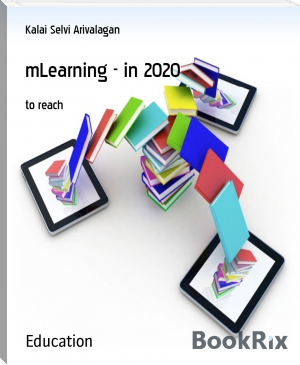INNOVATIONS IN SCIENCE, TECHNOLOGY AND MATHEMATICS EDUCATION IN NIGERIA by Ebele C. Okigbo, Nneka R. Nnorom, Ernest O. Onwukwe (the ebook reader .txt) 📖

- Author: Ebele C. Okigbo, Nneka R. Nnorom, Ernest O. Onwukwe
Book online «INNOVATIONS IN SCIENCE, TECHNOLOGY AND MATHEMATICS EDUCATION IN NIGERIA by Ebele C. Okigbo, Nneka R. Nnorom, Ernest O. Onwukwe (the ebook reader .txt) 📖». Author Ebele C. Okigbo, Nneka R. Nnorom, Ernest O. Onwukwe
Collaborative learning strategy is a kind of learning strategy in which students study together and achieve common goals. Each student contributes his/her own efforts in small groups to promote all students performance. In this process, students produce interaction to involve many activities such as communication, observation and support. Mckeachie (2003) explained that, in a collaborative learning class, students often elaborate on the concepts being taught to achieve what is expected. Collaboration not only enhances the learning of students who receive the explanation but also deepens the understanding of the student providing the explanation. The idea of collaboration is supported by Suchman (1987) theory of shared cognition which is deeply intertwined with the situated cognition theory. The theory states that the environment is an integral part of cognitive activities and not merely a set of circumstances in which context independent cognitive process are performed. Gambari, James and Olumorin (2013) investigated the effectiveness of video-based cooperative learning strategy on high, medium and low academic achievers. They found that video-based cooperative learning strategy enhanced the achievement of both low and high achievers. This could contradict what we know about collaborative and individualized instructions.
Individualized instruction is a method of instruction in which content, instructional technology (such as materials) and pace of learning are based upon the abilities and interest of each individual learner. According to Hall, Strangmen and Meyer (2011), it is an approach to teaching and learning that gives students multiple options for taking information and making sense of ideas.This enables the teacher to focus upon the specific needs and problems of individual student. Christian and Pepple (2012) studied collaborative and individualized learning strategies as predictors of students’ achievement in secondary school chemistry in Rivers State, Nigeria with sample size of 370. The findings showed significant effect of learning strategies on students’ achievement in chemistry with the following trend: Conventional<Individualized<Collaborative.
It is important therefore to compare the two learning strategies to ascertain the one that is more effective in enhancing mathematics achievement of secondary school male and female secondary school students in Afikpo Education Zone of Ebonyi State, Nigeria.Gender is the social fact of being male or female. It identifies masculinity and femininity in relation to patterns of human life. It is a central organizing principle of societies, and often governs the processes of production and reproduction, consumption and distribution (FAO, 1997). A great deal of studies had provided inconsistent reports on which gender that performs better in science and mathematics. The present research is a contribution to that effect.
Purpose of the Study
Generally, the study aimed at investigating the effect of collaborative and individualized learning strategies on students’ achievement in Mathematics. Specifically, the study aimed at determining the;
Difference between the mean achievement scores of students taught Mathematics using collaborative Learning Strategy (CLS) and Individualized Learning Strategy (ILS).
Differences between the mean achievement scores of male and female students taught Mathematics using CLS and ILS.
Hypotheses
The following null hypotheses were tested at 0.05 level of significance:
There is no significant difference between the mean achievement scores of students taught Mathematics using CLS and ILS.
There is no significant difference between the mean achievement scores of male and female students taught Mathematics using CLS and ILS.
Method
A quasi-experimental research design was adopted in this study. Specifically, the pretest posttest nonequivalent group design was adopted. The study was carried out in Afikpo Education Zone of Ebonyi State, Nigeria. A sample of 60 SS1 students obtained using multi stage sampling from a population of 8,275 mathematics students who enrolled for the 2018/2019 session was involved in the research. The researchers’ constructed Geometry Achievement Test (GAT) validated by three experts was used as instrument for data collection. Also lesson plans for experimental groups 1 and 2 were developed by the researchers and used as instructional tools. The reliability of GAT was established by single administration method and computed using Kuder Richardson Formula 20.This yielded internal consistency value of 0.89 which indicates that the instrument is reliable.
The researchers organized a two week training programme for the two teachers that taught the students. The teachers were trained in their respective schools in the zone. The pretest was at the initial stage administered simultaneously to the two groups:
Collaborative and Individualized groups before treatment started. The data from the test were kept for analysis. Classroom teaching took six weeks using the prepared lesson plans for the two groups. The teaching was done by the regular mathematics teachers for the chosen classes who were trained by the researchers. The topics for the instruction were extracted from the syllabus for the SSI at the study. The two groups were given the same content treatment and were taught with Collaborative Learning Strategy (CLS) and Individualized Learning Strategy (ILS) respectively. The posttest was administered immediately after completion of treatment. Data collected from the pre-test and post-test were statistically analyzed. Mean scores were used to answer the research questions while the null hypotheses were tested at alpha level of 0.05 using Analysis of Covariance (ANCOVA).
Results
Results were presented in tables according to research questions and hypotheses.
Table 1: Difference between the mean achievement and standard deviation scores of students exposed to Collaborative and Individualized learning strategies
Mean SD Mean SD Mean
Groups Pretest Pre-test Post-test Post-test diff
CLS 5.67 2.01 10.37 2.94 4.70
ILS 6.30 1.40 13.00 2.42 6.70
Mean Diff 0.63 2.63 2.00
From Table 1 reveals that the students taught geometry using ILS has a higher mean gain achievement scores than those taught using CLS
Table 2: Differences in the mean achievement scores of male and female students exposed to Collaborative and Individualized learning strategies
Male Female
Groups
Mean
Pretest
Mean Post-test
Mean Difference
Mean
Pretest
Mean
Post- test
Mean
Diff
CLS
4.60
9.67
5.07
6.73
11.07
4.34
ILS
4.00
11.73
7.73
8.60
14.27
5.67
Mean Diff
0.60
2.06
2.66
1.87
3.20
1.33
Table 2 shows that male students taught with individualized learning strategy (ILS) had a higher mean gain of 7.73 than the female (mean gain =5.67) counterparts taught the same way. Males taught with Collaborative Learning Strategy also have a higher mean gain of 5.07 and 4.34 for the females. Thus the difference in the mean achievement scores of male and female students in the two groups is 1.3
Table 3: Analysis of Covariance test of significant difference between the mean achievement scores of students in the treatment groups
Table 3 reveals that there is no significant difference (P = 0.054 > 0.05) in the mean achievement scores of SS 2 students taught geometry using ILS and CLS.
Table 4: Analysis of covariance test of significant difference in the mean achievement scores of male and female students in the treatment group
Table 4 reveals that there is no significant difference (P = 0.177 > 0.05) in the mean achievement scores of SS 2 male and female students taught geometry using ILS and CLS.
Discussion
The findings revealed that individualized learning strategy enhanced students’ achievement more than collaborative learning strategy but no significant difference exists in the achievement of mathematics students taught geometry with either collaborative or individualized learning strategies. The result also suggests that Individualized learning strategy (ILS) had greater effect on students’ achievement in Mathematics than Collaborative Learning Strategy (CLS). The findings gave credence to that of Christian and Pepple (2012) who studied collaborative and individualized learning strategies as predictors of students’ achievement in secondary school chemistry in Rivers State, Nigeria. Their findings showed significant effect of learning strategies on students’ achievement in chemistry with the following trend: Conventional < Individualized < Collaborative.
This finding also confirmed that of previous studies that established significant differences among the achievement gains of students taught with Individualized learning strategy compared with the Collaborative learning strategy (Adenye, Alfred & Samuel, 2012). The finding also supported Gan (2008) who found more positive effectiveness of individualized instruction on students’ achievement than the Collaborative Learning Strategy (CLS). However, the findings disagreed with that of Gambari, James and Olumorin (2013) who investigated the effectiveness of video-based cooperative learning strategy on high, medium and low academic achievers and found that video-based cooperative learning strategy enhanced the achievement of both low and high achievers.
Because the purpose of Individualized learning strategy is to build on what the students already knew and develop their critical analysis skills, the teacher’s lesson strategies included prepared questions carefully crafted to bring out the “big ideas” of the lesson. These focusing questions complement, rather than replace, the issues and ideas generated by the teacher and the students as the lesson progresses. The students received immediate feedback from the teacher who was present during the entire session and listened carefully to the discussion. They were not only made aware of what they knew, but also what they did not know or needed to know, which helped them develop a better understanding of the material and greater confidence in their knowledge (Diamond, 2007). It was possible since students were able to strengthen their confidence in their understanding of the material, and this could have led to improved achievement in mathematics.
The findings further revealed that no significant differences existed in the mean achievement scores male and female students taught geometry using ILS and CLS. This implies that being a male or female is not a determinant of the effectiveness of either of the two learning strategies rather, both male and female students benefited equally from the two of them. This finding confirms that of Tomlinson (2006) and Carbon (2007) who found no gender differences in academic language achievement of students taught with Individualized instruction method. The possible interpretation of this finding can be related to instructional factors. Literature indicated that despite clear roles for each type of gender, things seem to change under innovative and student-centered teaching such as ILS and CLS (Bansel, 2006; Berk, 2012). The finding of the present study is more convincing of the fact that with innovative instructional strategy such Individualized instruction, gender disparities in language classrooms could diminish.
Conclusion
From the findings, the study concluded that both individualized learning and collaborative learning strategies significantly enhanced the achievement of male and female students in geometry. However, individualized learning strategy was more effective than the collaborative learning strategy
Recommendations
Based on the findings of the study, the following recommendations are made:
Pre-service Mathematics teachers should learn how to use the ILSin the mathematics method class so as to assist students in engaging actively in Mathematics class.
Mathematics teachers should adopt and implement innovative strategies such as Individualized learning strategy in teaching Mathematics so as to improve students’ academic achievement.
Students should be made to participate actively and productively in Mathematics lessons. They should be exposed to teaching strategies such as group activities, and students generated ideas and questions to facilitate students’ achievement.
Curriculum planners should endeavor to make Individualized Instruction strategy form an integral part of the teachers’ training programs so as train teachers on their uses.
References
Adenye, O.A. Alfred, O.F & Samuel, A.O. (2012). Achievement in co-operative versus Individualistic goal-structured junior secondary school mathematics classrooms in Nigeria. InternationalJournal of Mathematics Trends and Technology, 3(6); 25-35.
Anaduaka, U. S.& Okafor, C. F. (2013). Consistent poor performance of Nigeria students in Mathematics in senior secondary certificate examination: What is notworking? Journal of Research in National Development, 11(1); 58-61.
Burke, B. & Dunn, D. (2002). Tools of the mind:The Vygotskian approach to early childhood education (2nd Ed), Upper Saddle River, NJ: Prentice Hall.
Carbon, M, (2007). Best practices for achieving high rapid reading gains. Principal, 87(2);42-45.
Chau, M.Y. (2005). Connecting learning styles and multiple intelligence theory through learning strategies: An online tutorial for library. Retrieved February 4th 2005 fromwww.libres.curtin.edu.au/libresibni/chau.htm.
Christian, M. & Pepple, T.F. (2012). Co-operative and individualized learning strategies as predictors of student’s achievement.Vocational Education and Technology, 9(2); 1- 6.
Diamond, R.G. (2007). The role of domain – specific knowledge in promoting generative reasoning ingenetic. In S.A Barab, KE.Hay & D.T. Hickey (Eds) Proceedings of the 7th International Conference for Learning, Making a Difference, 147-154, Mahwah.
Gambari, I.A., James, M. & Olumorin, O.C. (2013) Effectiveness of video-based cooperative learning strategy on high, medium and low academic achievers.The Africa Symposium: An Online Journal of the African Educational
 The desire to acquire knowledge about the surrounding world and human society is quite natural and understandable for a person. Life is so developed that an uneducated person will never occupy a high position in any field. Humanity in its mass, and each person individually, develops objectively, regardless of certain life circumstances and obstacles, but with different intensity. The speed of development depends on the quality of training.
The desire to acquire knowledge about the surrounding world and human society is quite natural and understandable for a person. Life is so developed that an uneducated person will never occupy a high position in any field. Humanity in its mass, and each person individually, develops objectively, regardless of certain life circumstances and obstacles, but with different intensity. The speed of development depends on the quality of training.




Comments (0)